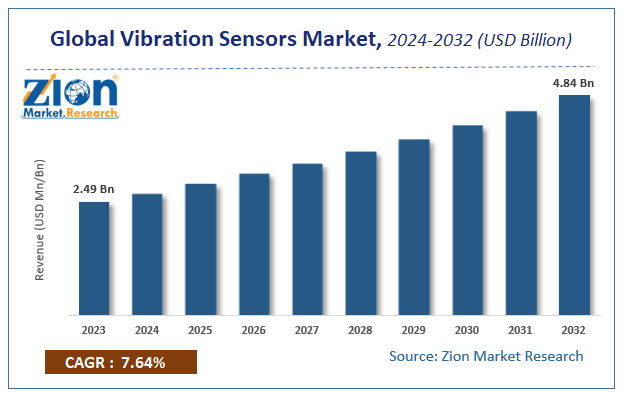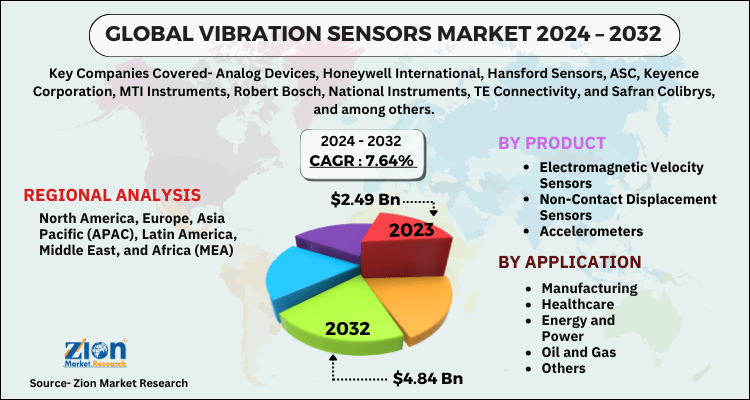Vibration Sensors Market Size, Share, Trends, Growth and Forecast 2032

Vibration Sensors Market By Product (Electromagnetic Velocity Sensors, Non-Contact Displacement Sensors, and Accelerometers) and By Application (Manufacturing, Healthcare, Energy & Power, Oil & Gas, and Others): Global Industry Perspective, Comprehensive Analysis, and Forecast, 2024-2032
| Market Size in 2023 | Market Forecast in 2032 | CAGR (in %) | Base Year |
|---|---|---|---|
| USD 2.49 Billion | USD 4.84 Billion | 7.64% | 2023 |
According to the report, the global vibration sensors market was USD 2.49 billion in 2023 and is expected to reach around USD 4.84 billion by 2032, at a CAGR of 7.64% between 2024 and 2032.
The report analyzes and forecasts the vibration sensors market on a global and regional level. The study offers past data from 2018 to 2023 along with a forecast from 2024 to 2032 based on revenue (USD Billion) and volume (K Units). The assessment of vibration sensors market dynamics gives a brief thought about the drivers and restraints of the vibration sensors market along with their impact on the demand over the years to come. Additionally, the report also includes the study of opportunities available in the vibration sensors market on a global level.
The vibration sensors market is driven by the growing adoption of automation in the manufacturing industry. The introduction of “Industrial Internet of Things” (IIoT) has led to the upsurge in the demand for vibration sensors. These sensors remotely capture simple vibrations and screen data in case of any imbalance or misalignment. Increasing funds in IIoT is expected to fuel the vibration sensors market in the years ahead. In 2016, IoT spending in the manufacturing industry was USD 178 billion and is expected to rise in the future. Furthermore, it is estimated that by 2023, IIoT will add USD 14.2 trillion to the global economy. Thus, the demand for vibration sensors is expected to rise in the upcoming years.
The growing sensors demand in the healthcare sector is fueling the vibration sensors market growth, as vibration sensors are mainly used in a wireless sensor network that consists of various sensors for measuring temperature, sound, light, and pressure. Various market players, such as TE Connectivity Ltd., are focusing on offering vibration sensors for the healthcare sector. However, maintaining regulatory compliance during the manufacturing of these sensors may adversely affect the market over the forecast time period. Alternatively, the adoption of advanced technologies, such as fiber optic sensors and laser interferometers, will open new growth avenues for this market in the upcoming years.
Global Vibration Sensor Market Drivers
The market drivers for the Vibration Sensor Market can be influenced by various factors. These may include:
- Industrial Automation: As manufacturing and industrial processes become more automated, there is a growing need for vibration sensors to track the condition of equipment, anticipate malfunctions, and minimize downtime—all of which improve operational efficiency.
- Predictive maintenance techniques are being used by industries more and more to cut maintenance expenses and limit equipment downtime. Vibration sensors are essential to predictive maintenance because they can identify irregularities and problems in machinery early on.
- Emphasis on Asset Health Monitoring: Vibration sensors are being used for continuous condition monitoring and asset management due to the necessity of keeping an eye on the performance and health of vital assets such motors, pumps, turbines, and rotating gear.
- Increasing Focus on Worker Safety: In sectors including manufacturing, mining, and oil and gas, ensuring worker safety is a top focus. Vibration sensors are used to keep an eye on the amount of vibration in the workplace and shield employees from dangerous vibrations, protecting their health and adhering to safety standards.
- Technological Developments: By providing more exact and effective vibration monitoring solutions, ongoing developments in vibration sensor technology, such as increases in sensitivity, precision, and wireless connectivity, propel market expansion.
- Growth of IoT and IIoT: As IoT and IIoT platforms proliferate, there are more chances to include vibration sensors into networked ecosystems for applications such as data analytics, predictive maintenance, and real-time monitoring.
- Growing Demand in the Automotive Sector: Vibration sensors are used by the automotive industry for applications such as predictive maintenance, engine condition monitoring, and vehicle health monitoring, which is fueling market expansion in this area.
- Growth in Aerospace and military: In the aerospace and military sector, vibration sensors play a crucial role in flight safety systems, structure health monitoring, and aircraft health monitoring. As a result, the market for these sensors is expected to grow.
- Adoption in Healthcare and Medical Devices: Wearable medical technology, patient monitoring, and diagnostic equipment are just a few of the uses for vibration sensors in healthcare that are fueling the industry’s expansion.
- Industries concentrate on enhancing energy economy and cutting down on energy usage in machinery and equipment. Vibration sensors stimulate demand for energy management products by enhancing machine performance, identifying inefficiencies, and preventing energy waste.
The report gives a transparent view of the vibration sensors market. We have included a detailed competitive scenario and portfolio of leading vendors operative in the vibration sensors market. To understand the competitive landscape in the vibration sensors market, an analysis of Porter’s Five Forces model for the market has also been included. The study encompasses a market attractiveness analysis, wherein all the segments are benchmarked based on their market size, growth rate, and general attractiveness.
Global Vibration Sensor Market: Segmentation
The study provides a crucial view of the vibration sensors market by segmenting it based on product, application, and region. All the segments of the vibration sensors market have been analyzed based on present and future trends and the market is estimated from 2024 to 2032.
By Product Analysis Segment includes Electromagnetic Velocity Sensors, Non-Contact Displacement Sensors and Accelerometers.Non-contact displacement sensors are expected to grow notably, owing to the technological advancements.
By Application Analysis Segment includes Manufacturing, Healthcare, Energy and Power, Oil and Gas and Others.The manufacturing segment is projected to substantially demand vibration sensors over the forecast years, owing to the increasing adoption of automation in various manufacturing sectors like automotive, consumer electronics, etc.
The Regional segmentation comprises the current and forecast demand for the Middle East and Africa, North America, Asia Pacific, Latin America, and Europe.
The Asia Pacific is estimated to hold a notable share of the global vibration sensors market in the future. South Korea, China, India, and Japan will witness huge product demand. The Middle East and Africa is projected to witness considerable growth in the vibration sensors market over the forecast timespan, owing to the growing sensors demand in the oil and gas sector. The UAE, Saudi Arabia, and Qatar are anticipated to be the most attractive countries in this regional market.
Global Vibration Sensor Market Restraints
factors can act as restraints or challenges for the Vibration Sensor Market. These may include:
- High Initial cost: The hardware, installation, and integration of the sensors with the current infrastructure or machinery all demand a substantial upfront cost when implementing vibration sensor systems. Some businesses, especially small and medium-sized firms (SMEs), may be discouraged from implementing vibration monitoring solutions due to the initial expense.
- Complexity of Implementation: It might be difficult and require specialist knowledge to integrate vibration sensors into industrial machinery or equipment. Adoption may be delayed by enterprises lacking in-house technical competence or resources due to the complexity of the installation and calibration processes.
- Compatibility problems: It can be difficult to guarantee that vibration sensors are compatible with current equipment, control systems, or data analysis platforms. Differences in data formats, software interfaces, or communication protocols might cause compatibility problems that cause delays and difficulties during integration.
- Data Overload: Large amounts of data are generated by vibration sensors, particularly in industrial environments where numerous sensors are monitoring numerous units. Vibration monitoring technologies can be rendered ineffective by firms lacking strong data analytics capabilities, as managing and analyzing this data to get relevant insights can be a daunting task.
- Noise and False alerts: Vibration sensors may produce noise or false alerts as a result of external influences, erratic equipment, or sensor failures. False alarms diminish vibration monitoring systems’ dependability and credibility by causing needless repair procedures or downtime.
- Restricted Knowledge and Education: The advantages of vibration monitoring for asset optimization and predictive maintenance may not be well known in some industries. Adoption can only be accelerated by educating potential clients about the value proposition and cost-saving advantages of vibration sensor technology.
- Regulatory Compliance: The use of vibration sensor solutions may be impacted by adherence to industry rules and standards pertaining to equipment upkeep, safety, and environmental protection. Vibration monitoring systems must comply with all applicable regulations, which increases implementation complexity and expense for organizations.
- Privacy and Security Issues: Sensitive information concerning the functionality of machinery, manufacturing procedures, or operational effectiveness may be contained in vibration sensor data. Organizations may be discouraged from implementing vibration monitoring solutions due to worries about data privacy, security breaches, or illegal access to sensor data.
Vibration Sensors Market: Report Scope
| Report Attributes | Report Details |
|---|---|
| Report Name | Vibration Sensors Market |
| Market Size in 2023 | USD 2.49 Billion |
| Market Forecast in 2032 | USD 4.84 Billion |
| Growth Rate | CAGR of 7.64% |
| Number of Pages | 143 |
| Key Companies Covered | Analog Devices, Honeywell International, Hansford Sensors, ASC, Keyence Corporation, MTI Instruments, Robert Bosch, National Instruments, TE Connectivity, and Safran Colibrys, and among others |
| Segments Covered | By Product, By Application and By Region |
| Regions Covered | North America, Europe, Asia Pacific (APAC), Latin America, Middle East, and Africa (MEA) |
| Base Year | 2023 |
| Historical Year | 2018 to 2022 |
| Forecast Year | 2024 - 2032 |
| Customization Scope | Avail customized purchase options to meet your exact research needs. Request For Customization |
Global Vibration Sensors Market Key Players
Some key players in the vibration sensors market are:
- Analog Devices
- Honeywell International
- Hansford Sensors
- ASC
- Keyence Corporation
- MTI Instruments
- Robert Bosch
- National Instruments
- TE Connectivity
- Safran Colibrys
This report segments the global vibration sensors market into:
Global Vibration Sensors Market: Product Analysis
- Electromagnetic Velocity Sensors
- Non-Contact Displacement Sensors
- Accelerometers
Global Vibration Sensors Market: Application Analysis
- Manufacturing
- Healthcare
- Energy and Power
- Oil and Gas
- Others
Global Vibration Sensors Market: Regional Analysis
- North America
- The U.S.
- Europe
- UK
- France
- Germany
- Asia Pacific
- China
- Japan
- India
- Latin America
- Brazil
- Middle East and Africa
Table Of Content
Methodology
FrequentlyAsked Questions
The global vibration sensors market accounted for USD 2.49 Billion in 2023 and is expected to reach USD 4.84 Billion by 2032.
The CAGR value of the vibration sensors market is expected to be around 7.64% during 2024-2032.
The Asia Pacific is estimated to hold a notable share of the global vibration sensors market in the future.
Some key players of the global vibration sensors market are Analog Devices, Honeywell International, Hansford Sensors, ASC, Keyence Corporation, MTI Instruments, Robert Bosch, National Instruments, TE Connectivity, and Safran Colibrys.
RelatedNews
HappyClients
Zion Market Research
Tel: +1 (302) 444-0166
USA/Canada Toll Free No.+1 (855) 465-4651
3rd Floor,
Mrunal Paradise, Opp Maharaja Hotel,
Pimple Gurav, Pune 411061,
Maharashtra, India
Phone No +91 7768 006 007, +91 7768 006 008
US OFFICE NO +1 (302) 444-0166
US/CAN TOLL FREE +1 (855) 465-4651
Email: sales@zionmarketresearch.com
We have secured system to process your transaction.
Our support available to help you 24 hours a day, five days a week.
Monday - Friday: 9AM - 6PM
Saturday - Sunday: Closed







